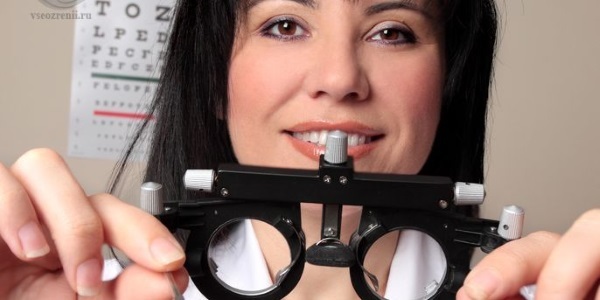
Glasses - this is one of the most accessible and tested optical instruments for vision correction.
Combining the achievements of medical science and the introduction of advanced industrial methods has generated a huge variety of glasses in which you can choose an accessory that matches the individual characteristics of the organism and helps even with exotic disturbances.
But do not immediately start wearing glasses at the first symptoms of vision impairment - you first need to analyze the situation and understand whether they really are necessary in this case.
Glasses perform the function of external lenses, correcting the work of natural human lenses - the lens and the cornea.
Accordingly, their main purpose is the correction of diseases, in which the work of these organs is disrupted, which prevents a person from independently obtaining a clear picture in the eyes.
- 1. Possible violations of
- 2. Vision and army
- 3. Wearing
- glasses 4. Results of
- 5. Video to
point Possible violations of
These diseases are represented by myopia, hyperopia and astigmatism. Myopia and hyperopia are types of ametropia - a disorder in which light rays do not focus on the retina. In myopia, the rays converge in front of the retina, which leads to the impossibility of looking at far-located objects.
As a rule, this is a consequence of the irregular shape of the eye, its elongation. With hypermetropia( farsightedness), short light rays are not refracted with sufficient force, so they converge behind the retina, which leads to the impossibility of clearly seeing close. This happens when the accommodation muscles are weakened and when the lens is lost elasticity.

With astigmatism, the light rays converge at the optimal distance, but they are unevenly focused in the horizontal plane of the retina. This leads to an unclear image of any range. Most often, astigmatism is caused by a violation of the correct shape of the cornea or lens.
The severity of the disease is determined by the refractive power of the eye lens, measured in diopters. Myopia corresponds to a negative number of diopters, farsightedness - positive.
The lowest degrees of these diseases correspond to the number up to 3.25 D, for the middle stages of disorders the range 3.25-6.5 is typical, the severe forms of pathology begin with 6.5 and more diopters. This gradation is the same for myopia and hyperopia and differs only in sign before the number( + or -).
It is worth noting that special types of eyeglasses can be prescribed for diseases not associated with a violation of image focusing. For example, cataracts use glasses with darkened lenses that protect the damaged lens from the harmful effects of light rays.
Sight and army
The established category of fitness for service depends on the disease and its severity.
So, with myopia within 3-6 diopters, the draftee is subject to conscription( group B), but with restrictions on the loads and deliveries of troops. Myopia 6-12 diopters relieves a man from conscription in peacetime( group B), and myopia with an indicator of more than 12 Dpts completely frees a person from military service( group D).
The criteria for the validity of hyperopia are almost identical, with the exception that group B is given at 6-8 diopters, and group B at 8-12 diopters.
With astigmatism, exemption from service is given at 6-4 diopters, and a man is completely unfit for a value of more than 6 diopters.

Wearing glasses
The need for glasses depends on the stage of the disease and its causes. So, with myopia associated with the wrong shape of the eye, glasses are extremely necessary to prevent overstrain of the visual muscles and further squeezing the eyeball. If they are not worn, the disease will only degrade.

With accommodative myopia associated with spasm of the visual muscles, glasses can only do harm. This form of the disease is eliminated by strengthening therapy and regular gymnastics to restore muscle tone, and wearing them only relaxes and further degrades.
With hyperopia, you should alternate wearing glasses with periods of rejection.
Constant refusal of the use of optical lenses can lead to eye strain and spasm of accommodation, but their constant wearing unduly relaxes muscles, contributes to the faster development of hyperopia.
With astigmatism, constant wearing of glasses is mandatory in all cases, except very weak forms of the disease - then it is enough to wear them only for reading.
Neglecting this can lead to further progression of the disease and the development of strabismus and amblyopia. When astigmatism uses special glasses with lenses of a cylindrical shape.
The mode of wearing glasses depends on the degree of violation. If myopia or hyperopia is in the range of 3-5 diopters, then glasses are only prescribed when working with small and difficult objects( reading, sewing).

If the disease manifests itself in more serious disorders, then it is prescribed to constantly wear glasses or replace them with contact lenses.
It is possible to assign several pairs of glasses, each of which specializes in one kind of activity, for example, reading glasses, goggles and so on.
Closely monitor the wearing of glasses by children. Require their donations when attending school, while doing homework, watching TV and working at the computer.
Separately, it should be mentioned about wearing glasses by car drivers. When passing a medical examination to obtain a driver's license, they are marked with a vision.
If a person finds violations of his severity( both nearsightedness and farsightedness), then he is obliged to wear glasses( or contact lenses) while driving a car. A traffic police officer has the right to stop the driver and verify compliance with this requirement, if there is a violation, a penalty is issued.
You can restore your eyesight with:
- Bates method
- Massage for vision improvement
- Excimer laser correction
Results
Constant wearing of glasses is mandatory for medium and severe forms of diseases such as astigmatism, nearsightedness, farsightedness. In the early stages of impairment, glasses are worn only when working with small objects, or are not worn at all, if the disturbances are caused by short-term negative effects on the eyes.
In case of poor vision, wearing glasses is mandatory when driving a car, for violation of this requirement, a fine is required.
Video to the point
We bring to your attention a useful video:
